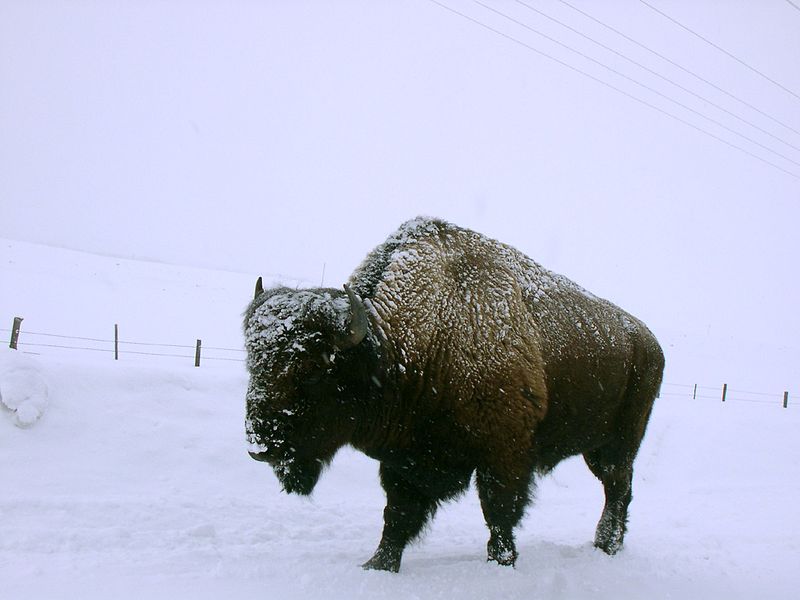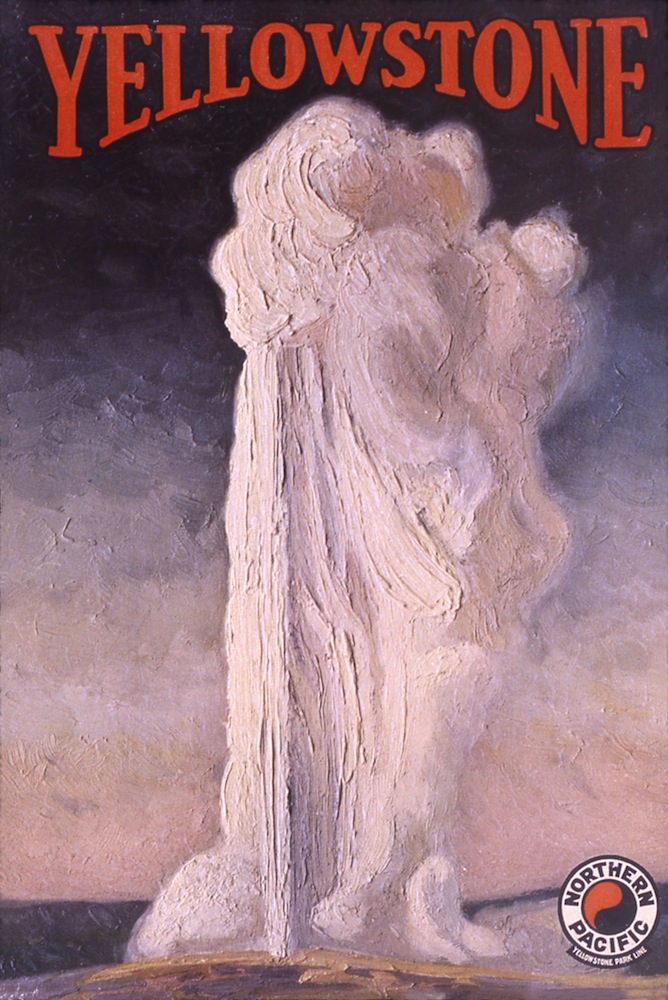
WEST YELLOWSTONE, Mont. – West Yellowstone is one of those places steeped in history, blessed with snow, and encouraging of all-comers. Come to think of it, there’s not many places in the world like it, which is why U.S. Ski Team coaches like Marty Hall deemed it a perfect fit for their annual Fall Camp starting in 1978.
On Tuesday night, Thor Godar, self-proclaimed keeper of the gates at the Rendezvous trailhead and a historian at the Yellowstone Historic Center, spoke to festival-goers about the history of skiing in West Yellowstone. Several parts of his presentation are woven into the following facts about West Yellowstone – by the numbers.
-66: Lowest recorded temperature (Fahrenheit) in West Yellowstone, on Feb. 9, 1933.
-53: A pretty darn cold low (Fahrenheit) recorded three years ago.
-16: Temperature (F) last Friday.
3: Inches of snow Yellowstone Ski Festival organizers had to work with as a base last November on the South Plateau – one of the lowest on record.
8: The length of the cross-country skis (in feet) locals used to trek around town (and miles away for food and supplies) more than a century ago.
10: Inches of snow in town on Tuesday, Nov. 26, with about 3 ½ feet at higher elevations.
15-16: Inches of new snow at higher elevations on the Rendezvous Ski Trails, thanks to a storm last week.

25: Percent chance that Windy Ridge Loop is open during the Yellowstone Ski Festival. It opened on Monday.
32: The previous typical high temperature during winter in West Yellowstone. Back in the day, it rarely got above freezing, Godar explained. Occasionally, warm “Chinook” winds push daytime temps into the 40s, according to National Park Travel.
35: Years since the first Fall Camp, which started in 1978 with then-U.S. Ski Team coach Marty Hall and skiers like Bill Koch, Dan Simoneau and Tim Caldwell. Koch didn’t come too many years after because of exercise-induced asthma, which worsened with altitude.
35-plus: Kilometers open at the Rendezvous Ski Trails – basically all of it.
100: Estimated population of West Yellowstone when it was founded in 1908. By 1910, it was up to 140.
171: Inches of snow fall annually, on average, in West Yellowstone. Nearby ski resorts like Grand Targhee in Alta, Wyo., receive more (around 500 inches per year), but West usually keeps most of theirs. The secret? “Ferociously low temperatures,” Godar said.
400-500: Estimated skiers on the Rendezvous Ski Trails on Tuesday, four days before the season-opening U.S. SuperTour race there (with a freestyle sprint on Friday and 10/15 k freestyle race on Saturday).
600-650: Competitive racers at the Yellowstone Ski Festival last year. This year, participation is expected to reach new highs.
1271: Population of West Yellowstone in 2010.
1807: Part of the Lewis and Clark Expedition, John Colter, becomes the first-known white man to explore Yellowstone National Park (before it was officially established). Native Americans had Colter beat by about 13,000 years, and trappers, including French Canadians, also set foot inside the park before him.
1862: Skiers start to explore the park. Uncle Billy Hofer was perhaps the first to circumnavigate the park on skis in 1979. He later became a scout for the U.S. Army when it came to Yellowstone to discourage poachers.
1872: Yellowstone National Park established, spanning 2,219,789 acres across Wyoming, Montana, and Idaho. Approximately 96 percent of the park is in Wyoming, 3 percent in Montana, and 1 percent in Idaho.
1887: Park opened to winter travel, thanks to Lieutenant Schwatka, who didn’t exactly succeed in his expedition to do so. He and his scouts were severely overdressed and packed way too many supplies. Swatka got sick before entering the park and called it quits at a nearby hotel, but his crew pressed on – including Frank Haines, who dubbed himself the official park photographer.

1886: Congress decides to stop poaching (elk, bison, etc.) in the park and stations the U.S. Army there. With troops from Arizona, most of the men weren’t too keen on winter, and enforcement lacked as a result. Scouts from the area ended up showing them the ropes and together they build snow cabins around the park. These men, stationed there by the thousands, became the forerunners of the National Park Service. They skied 15 to 20 miles per day and were in darn good shape, Godar said.
1894: Since there was no law against poaching, the bison population went as low as 25 in West Yellowstone, no thanks to a notorious poacher named Howell. The army eventually caught and imprisoned him, but couldn’t convict Howell of any criminal wrongdoing. That prompted Congress to pass the Lacey Act of 1894 to end poaching in West Yellowstone.
1908: The town of West Yellowstone founded, thanks to the Union Pacific Railroad’s extension of the Oregon Short Line to the west gate of the park. According to Godar, the town started as a tourist trap (with the park as the main attraction) and still is.

Without any roads, the railroad was the only means of mechanical transportation in and out of West Yellowstone, and was closed November through March (many transporting tourists June-September). That left West in complete isolation during the winter, and skiing was the best way to get around. Skiers first came to the area to deliver products and goods, including mail and food, like they did in nearby mining towns, including Cooke City.
Knowing the railroad was coming, Yellowstone park employee and a local bartender Sam Eagle bought a piece of commercial space next to the railroad’s right of way. Today it remains in the family trust as Eagle’s Store, near the Freeheel & Wheel ski and bike shop – a local favorite (est. in 1996).
Eagle and his wife, Ida, had 10 kids: nine boys, the youngest of which went on to ski for Montana State College’s first-sanctioned team: Walter Eagle. Wally became the first paid ski coach at Gallatin County High School, instructed at the former Lionhead alpine area near West Yellowstone, and was on the board for Bridger Bowl in Bozeman, Mont., according to The Bozeman Daily Chronicle. Part of the U.S. Freestyle Moguls Team, Olympian Heather McPhie is a great-granddaughter of Sam and Ida Eagle.
1935: First plowed streets in West Yellowstone.
1941: With fears of World War II looming, the U.S. Army considers starting first ski division in Yellowstone. Trumpeter swans were nearing extinction at the time in nearby Island Park (the poachers again), and one Congressman exclaimed that they couldn’t bring the military to such a delicate region. Instead, they established a base in Colorado, which became the 10th Mountain Division.
1948: Lionhead, West Yellowstone’s first ski hill, established, but “wildly unsuccessful,” according to Godar. Despite plowed town roads, the dirt routes that led to West were too harrowing to drive in the winter.
1971: High-school ski teams start coming to West for preseason skiing, with camps that started as early as September on the South Plateau.
1978: U.S. Nordic Ski Team comes to town for the first of many Fall Camps, and the Rendezvous Ski Trails, founded by Neal and Grace Swanson, become a go-to destination.
1980: First Ski Rendezvous Race (50 k classic), which reached an all-time high with 900 skiers seven years ago. Next year’s Yellowstone Rendezvous Race (with distances of 2 k, 5 k, 10 k, 25 k classic, 25 k and 50 k) is set for March 8, 2014.
1984: Rendezvous groomer Doug Edgerton starts his own company, Yellowstone Track Systems, which distributes grooming equipment worldwide. Edgerton worked many high-profile events since, including several Olympics like the 2002 Winter Games in Salt Lake City, where he was chief of course preparation. “In my opinion, [he’s] the best groomer in the world,” Godar said.
2002: Many of the world’s best biathletes come to West Yellowstone to train for the Olympics. According to Godar, they racked up 18 medals that year.
2004: Fall Camp renamed the Yellowstone Ski Festival (YSF).
3,000-3,500: Anticipated total participants in this year’s YSF, a near-record, up from around 2,000 last year, Godar said.
6,663: Elevation of West Yellowstone. The Rendezvous Ski Trails are about 6,800 feet above sea level (2,000 meters), and the South Plateau just outside the park is about 1,000 feet higher.
***
See also: Another Strange Year for West, in a Good Way (Photo Gallery)
Alex Kochon
Alex Kochon (alexkochon@gmail.com) is a former FasterSkier editor and roving reporter who never really lost touch with the nordic scene. A freelance writer, editor, and outdoor-loving mom of two, she lives in northeastern New York and enjoys adventuring in the Adirondacks. She shares her passion for sports and recreation as the co-founder of "Ride On! Mountain Bike Trail Guide" and a sales and content contributor at Curated.com. When she's not skiing or chasing her kids around, Alex assists authors as a production and marketing coordinator for iPub Global Connection.

3 comments
Tim Kelley
November 27, 2013 at 12:22 pm
More local history: Before the USST came to West in ’78, they had a ’77 fall camp at Cooke City, on the NE side of the park. This camp ended up being 6 weeks of skiing on a 600 meter loop that was made by shoveling snow from small snowdrifts into the back of the tiny first generation Subarus that the USST was sponsored with, and then spreading the snow on a the loop in a field. To add to the mental pain and boredom of this loop, once the USST got to Cooke City, we heard that it had snowed heavily back east. Kochie was smart and stayed in VT.
At this camp USST’er Lynn Spencer, and her husband, got in bad car wreck in a USST Subaru (went off the road and down into a canyon) and they were very lucky to live through it. The Subie was totaled.
To counter the boredom of loop skiing we would go hiking every few days. One club skier from Vail (Kurt Vanion?) was out hiking and slipped while coming down some mining talus. When he went to get up he looked next to his hand and there was a gold nugget lying next to it. The locals in the bar of the motel we were staying at offered him $100 for the nugget. He kept it. It would probably be worth around $2000 today.
zimborst
November 27, 2013 at 9:13 pm
Another interesting historical tidbit is that Yellowstone was protected in part early on by black US Army troopers on bicycles. There’s some great photos of this era, probably accessible online, the troopers with their bikes arrayed at Mammoth Hot Springs on the terraces. In the late 1970s the US Ski Team checked out skiing at Grand Targhee, which gets early snow and keeps it due to high elevation (8000+’), but it is a difficult and challenging place to ski, due to that elevation and steep hills, despite great beauty. Targhee has had groomed tracks for a couple of weeks already this winter, with a 43″ base. Local trails are starting to be groomed by our local nonprofit, Teton Valley Trails and Pathways (www.tvtap.org). Y’all come visit! JB, Teton Valley local nordic geek
Pingback: binary options brokers free demo account